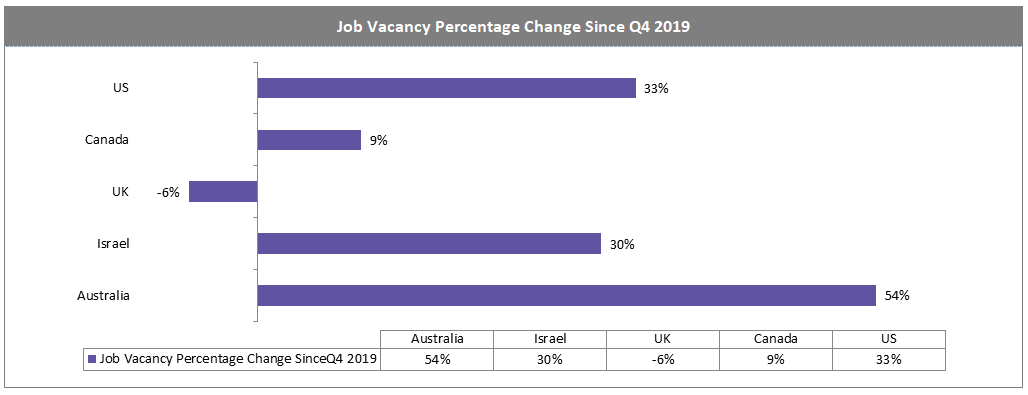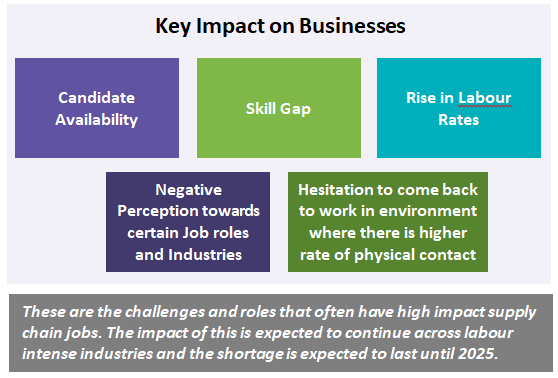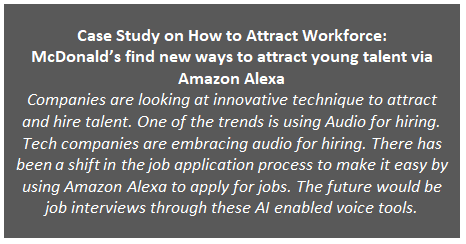
The great resignation or the time for the great realization – would labor shortage have a long term on the supply chain?

Labor Supply and Demand Trends and Developments
The most spoken topic in every HR and supply chain labor forums off-late has been the great resignation and concerns over filling the void created within organizations. Shortage of labor and the increasing rate of resignations have been impacting the hiring cost and the overall cost for production and services.
As the COVID-19 pandemic continues to present challenges to all the major economies, labor shortages are contributing to the ongoing supply chain disruptions facing many industries. Companies are finding it difficult to find the right candidates for the jobs they are looking to fill while millions of active workers are quitting their jobs or moving out of organizations for better working conditions.
One of the major industries that have been impacted by the labor shortages caused due to COVID-19 is the shipping and warehousing industry. Most of the ports across the globe do not have sufficient workforce to unload goods of ships, causing shipping delays. One such example is that of the stagnation of goods movement in the port of Los Angeles, impacting shipping across the US.
The increasing shortage of truck drivers and factory operators has been mounting the pressure on supply chain managers. This is anticipated to impact the economic growth as well for various regions. Approximately 90% of the leaders and members of the US Chamber of Commerce considers this to be a major concern to economic growth in various regions in the US.

However, the effects of labor shortage are not equally distributed. The negative perceptions on the work quality and low pay make labor shortage critical for manufacturing and supply chain industries. The employees have been flocking to attractive industries such as technology and healthcare.
What happened to the Labor Supply?
Seasonal and temporary shortage of labor is not news to developed economies with high industrial activities, however what is new to these economies is that the workforce shortage coincides with ever spiking unemployment rates. The number of job openings has spiked in the US, Singapore, Germany, Australia and Canada and the employment rate dipped much below compared to the pre-pandemic peak.

The major reasons for this are attributed to the preferential changes in terms of type of work, industries and location where the employees want to work. This is also spiced up with other pandemic related policy changes by regions and organizations and the risk associated with coming back to work.
- Industry Labor Specific Shortage
- The current shortage for workforce in certain industries is due to the switching of occupations and industries as there were shutdowns of industries leaving millions unemployed. The blue-collar workers were left in trauma of unemployment pushing most of them away from their original industry of focus and moving to more lucrative and safer work places. The increasing shortage of truck drivers and factory operators has been mounting the pressure on supply chain managers. This is anticipated to impact the economic growth as well for various regions. Approximately 90% of the leaders and members of the US Chamber of Commerce considers being a major concern to economic growth in various regions in the US.
- Fear of the pandemic paving way to early retirement
- A survey in the US showed that over 3 million people were unemployed due to fear of catching COVID-19 in June. Baby boomers and generation-x has begun to recede the labor force in most of the countries and millennials and gen-z are growing in the talent pool. The fear of pandemic has been forcing older employees to resign.
- Lack of welfare benefits leading to gender disproportionate workforce
- Lack of childcare benefits has had a disproportionate effect on working mothers around the worked, forcing them to drop out of the labor force during the pandemic. Most of the working mothers had to put their family first due to the lockdown of daycares, schools and shortage of domestic helps.

- Back to smaller cities and towns
- Remote working and initial lockdowns have spurred the movement of talent to move back to smaller cities and town or back to homes, resulting in shift of the net available workforce in business hubs and districts.
- Restrictions in international labor movement
- The pandemic has imposed restrictions in travel in most parts of the world. It is estimated that 1.3 million non-UK workers left the country during the pandemic. Canada also witnessed a dip in the migration process during the first two quarters of 2021. Australian businesses have also reported considerable labor shortages, attributed majorly to tough border controls and lack of applicants. Strict limits on international movement have also been hurting business hubs like Singapore, where migrant workers account for about 38% of the workforce.
- Government policies delaying reallocation of workers
- Many governments in the wake of the pandemic and lockdowns provided extensive unemployment benefits, however this is also assumed to have contribute to the worker shortage. The unemployment package in the US offered cushioning and protection and have fulfilled the needs of the workforce even by staying away from work. Some developed countries offered furloughs and short-time work schemes instead of providing unemployment benefits and was proved to be more effective in preserving the employer-employee relationship and smoother back to work schemes. The employers were kept on the payrolls and government subsidized the lost wages.
How to combat the existing workforce shortage?
The solutions for labor shortage cannot be combated just at an organization level but have to be addressed at country level. One-fit-all approach will no longer work as there is a greater emphasize on flexibility and the definition of flexibility is highly expandable based on the priority of each individual.
- Increase Immigration to combat Seasonal and Long-term Labor Demand
- Developed countries should consider increasing the immigration processes by offering more worker visas in order to bring more talent to the country. The immigration numbers have remained flat and there haven’t been as many visa options for employers to meet seasonal or temporary work visas to bring in talent for man services industries and roles. The US Chamber of Commerce has requested Congress and the White House to double the cap on employment-based visa, especially for H-1B and H-2B visas for temporary and seasonal workers.

- Provision to work remotely
-
Industries that have the provision of remote working should make flexible arrangements for employees as this would help drawing more applicants. Based on surveys conducted by recruitment consultants it was found that substantial share of workers and applicants desire such arrangements and willing to work where they can work with this option.
-
In labor intense industries, where remote working is not an option, organizations should consider investing in technology to boost the productivity of the available workforce.
- Promote vaccination and health benefits
- Promoting vaccination and safer workplace policies would be essential to elevate the confidence of supply chain workforce to get back to work. Better workplace conditions and family welfare and care support would enable more workforces to return back to work.
- Higher wage rates for manufacturing and logistics roles
- Higher labor rates will also attract workforce. The wage rates across certain sectors such as manufacturing; logistics, warehousing, and mining have been relatively low. Offering starting and sign-on bonuses and increasing the transparency of salary information on job ads would help attract more talent.
According to studies by Research and Employment Confederation, 88% of the recruiters said that labor shortage is the biggest concern in 2021 and 97% of them said that it is taking longer time to fill vacancies. This would mean that the cost to organization specifically on the labor component would rise by at least 30% in most of the regions over the next two years.
As the active workforce is weighing the quality of work, flexibility, salary and benefits, it is essential for HR and Procurement leaders to reassess their current hiring and retention strategies. HR leaders must include workforce optimization and automation in their strategic priorities for 2022.
References
- https://www.forbes.com/sites/forbeshumanresourcescouncil/2021/10/19/five-reasons-labor-shortages-are-impacting-supply-chains/?sh=45d8bb55b94b
- https://www.natlawreview.com/article/how-labor-shortage-impacting-supply-chain-would-immigration-reform-help
- https://www2.deloitte.com/xe/en/insights/economy/global-labor-shortage.html
- https://www.adeccogroup.com/future-of-work/latest-insights/the-blue-collar-labor-shortage-and-redefining-the-new-normal-top-5-trends-from-the-world-of-work/
- https://www.adeccogroup.com/future-of-work/latest-insights/the-surprising-way-that-mcdonalds-attracts-young-talent/
- https://www.conference-board.org/topics/labor-shortages
- https://www.rec.uk.com/our-view/research/industry-analysis/labour-and-skills-shortages-1
- https://blog.workday.com/en-us/2021/where-hr-heading-2022-what-4-workforce-trends-reveal.html
- https://www.businessinsider.in/policy/economy/news/the-labor-shortage-is-permanent-survey-suggests/articleshow/88060594.cms
- https://www.cnbc.com/2021/10/20/global-shortage-of-workers-whats-going-on-experts-explain.html
- https://www.bls.gov/news.release/pdf/empsit.pdf
- https://edition.cnn.com/2021/06/29/economy/global-worker-shortage-pandemic-brexit/index.html
- https://www.weforum.org/agenda/2021/05/solving-the-mystery-of-the-worker-shortage/
- Beroe Analysis
Related Insights:
View All
Get more stories like this
Subscirbe for more news,updates and insights from Beroe






